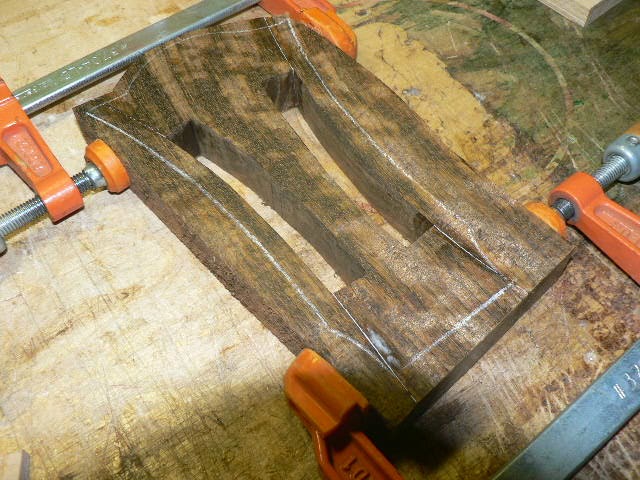I installed lattice bracing for the Nylon model. Lattice bracing is made by European red spruce same as the top material. I have been using the vacuum clamping system for the gluing process for the lattice. Vacuum clumping is able to apply stronger and uniform pressure for the clumping. Also, the water based glue cures much faster in the vacuum environment. 20-minits is enough to apply clumping force for the lattice install. After install the lattice, I shaved the lattice brace as a triangle cross section to minimize weight. This is a time consuming process; however, removing excess bracing materials improves sound quality dramatically.
I also made a sound hole, and installed a Rosetta. Rosetta has a simple black-white-black border design. Outside trim for the Rosetta is Ebony. Internal borders are made by maple and black dyed maple. This nylon model has an unique offset oval sound-hole that works as conventional sound hole and sound side port. Also, this offset sound hole layout generates much stronger buss tone no matter what bracing pattern is used.
Kohei Fujii Guitars

Sunday, January 25, 2015
Sunday, January 18, 2015
Rosette Install
I installed a rosette on the top for the SSJ model. This rosette design is a random pattern using different wood patches from Myrtle, Tamarind, Ebony, King wood (purple), Cocoboro, and Honduran rosewood. Those patches are leftovers from my previous work. I have many small pieces for all kind of exotic wood. So, this rosette is a pretty good design for saving waist. I also installed an Ebony trim inside the sound hole. I have been using the wood trim inside the sound hole, because the wood trim works as a moisture sealing. The Ebony trim makes more sharper image for the sound hole.
Sunday, January 11, 2015
Top making start
I start making tops. Nylon model has been exclusively using the European Spruce. Second photo is the European Spruce top for the Nylon model. For the SSJ model, I will use a Lutz spruce from a Canadian supplier. Lutz spruce is a naturally hybridized wood between Sitka spruce and Engelmann spruce. This wood has the material property between Sitka and Englemann. Sitka is a very hard material, and generates very strong fundamental tone. Englemann is a very soft material, and not suitable for steel strings guitar tops for me. I like the material between Sitka and Englemann. Beauty of this material is very high quality with decent price. Third photo is the Lutz spruce top for the SSJ model. This material has full of silk pattern. Silk pattern only appears from the perfectly quartered wood. This top has almost perpendicular grains all over the top. This is a true premium grade top material. However, material contribution for the tonal quality is very small. Making and bracing tuning skills define probably 99% of tonal quality. Only 1% is the material contribution. Actuary, I am able to make similar tonal quality form a student level material. Only difference is cosmetically advantages.
I also am working on the Rosette making. I will use spoiled Tamarind, Ebony, Cocoboro, King wood, Myrtle, and Indian Rosewood.
I also am working on the Rosette making. I will use spoiled Tamarind, Ebony, Cocoboro, King wood, Myrtle, and Indian Rosewood.
Sunday, January 4, 2015
Side assembly complete
Both SSJ and Nylon models, side assembly completed. I made solid linings for both models. While installing solid linings, I also installed a beveled arm rest for the SSJ and floating arm-rest anchors for the nylon model. Beveled armrest does not work well for nylon model, because of the thin body shape and the playing style. Also the purpose of the arm-rest is different. Nylon model requires an isolation between the right arm and the guitar top. Due to the very thin top thickness, right hand arm on the guitar's lower bout kills sound quality. To solve this issue, the floating arm-rest has been installing my nylon modes. Steel strings guitars are less sensitive to the connected right hand arm over the sound board. So, I have been using the beveled arm rest for enhancing play ability.
Now, both sides are ready for installing the top and the back.
Now, both sides are ready for installing the top and the back.
Saturday, January 3, 2015
V-joint Neck with square slots is my signature design
V-joint neck with square slots are very unique design. My nylon model has a Jazz guitar like head design with curved square slots. Usually, machine heads (tuning machines) are three integrated design for Nylon strings guitars. Therefore, all nylon strings guitars have non curved slots until today. I wanted make a Jazz guitar like head with curved slots. I found individual tuning machines with very small foot print that is compatible with the standard 15mm post-to-post distance. Then, I designed segmented outline to make the curved layout. I also realized a square slot design. To make the square slot that requires complicated slot cutting works, I have to make the head individually from the neck. Therefore, I introduced the v-joint technique. V-joint required super precise alignment between the head and the neck to make a seamless joint as you can see #4 photo. With spending extra time for shaping, alignment and gluing, the completed neck is very unique and beautiful. Nobody-else has ever realized this unique Jazz guitar inspired slotted head design. I am very proud of my unique head design. Unique guitar head design is the guitar maker's signature. My head design is the curved square slots.
Subscribe to:
Comments (Atom)



















